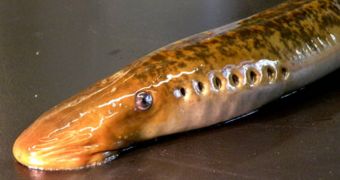The sea lamprey is one of the weirdest fish in the oceans, and is a direct descendant of animals that lived millions of years ago. This earned it the classification of “living fossil,” because it also looks very strange, as if from a different time. Now, researchers have discovered that there's more to the fish than meets the eye, and that it has one of the least met traits in the animal world – namely to shed as much as one fifth, or 20 percent, of its genome as it develops into an adult.
In charge of the research that led to this conclusion was University of Washington in Seattle (UWS) expert Jeramiah Smith. The expert wanted to piece together the fish's genetic sequence, but immediately realized that something was amiss. Working together with a team of experts from the University, he used an analysis technique that detected broken DNA to figure out exactly what was wrong, ScienceNow reports. In this method, every cell in an embryo is labeled as dying.
The researchers were amazed to find out that DNA collected from lamprey sperm (LS) was much richer than the one found, for instance, in the fish's liver. One of the things that the scientists noticed about the LS they analyzed was that it exhibited a highly repetitive sequence of DNA known as Germ1, which they set as a marker. In the developing lamprey, they analyzed the way in which Germ1 concentrations endured, and also tried to figure out the patterns in which the fish was shedding its genetic material.
California Institute of Technology Developmental Biologist Marianne Bronner-Fraser said that the new study could open up new directions for thought in biology, as “It's contrary to what you generally think happens in vertebrates.” The expert underlined the fact that higher animals usually tended to suppress their genes, or make them inactive by surrounding them with inhibitor chemicals, rather than getting rid of them completely, which appeared to be a bit extreme.
“The real breakthrough will come when someone is able to figure out the mechanism by which [genetic material shedding] occurs,” University of Ottawa Molecular Biologist Guy Drouin added.

 14 DAY TRIAL //
14 DAY TRIAL //